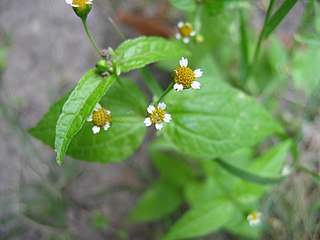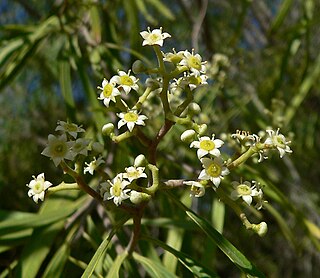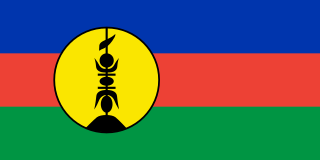
Eragrostis is a large and widespread genus of plants in the grass family, found in many countries on all inhabited continents and many islands.

Aesculus parviflora, the bottlebrush buckeye, is a species of suckering deciduous shrub in the Sapindaceae family. The species is native to the southeastern United States, where it is found primarily in Alabama and Georgia, with a disjunct population in South Carolina along the Savannah River. Its natural habitat is in mesic forests, on bluffs and in ravines.

Gaura parviflora is a species of Gaura native to the central United States and northern Mexico, from Nebraska and Wyoming south to Durango and Nuevo Leon.

Galinsoga parviflora is an herbaceous plant in the Asteraceae (daisy) family. It has several common names including guasca (Colombia), mielcilla, galinsoga, gallant soldier, quickweed, and potato weed.

Cyperus eragrostis is a species of sedge known by several common names, including tall flatsedge, nutgrass, tall nutgrass, umbrella sedge, chufa, Earth almond, zula nuts, edible galingale and pale galingale.

Collinsia parviflora is a species of flowering plant in the family Scrophulariaceae known by the common names maiden blue eyed Mary and small-flowered collinsia.

Malva parviflora is an annual or perennial herb that is native to Northern Africa, Europe and Asia and is widely naturalised elsewhere. Common names include cheeseweed, cheeseweed mallow, Egyptian mallow, least mallow, little mallow, mallow, marshmallow, small-flowered mallow, small-flowered marshmallow and smallflower mallow. M. parviflora leaf extracts possess anti-inflammatory and antioxidant activities. It has a decumbent or erect habit, growing up to 50 cm in height. The broad leaves have 5 to 7 lobes and are 8 to 10 cm in diameter. It has small white or pink flowers with 4 to 6 mm long petals.

Eragrostis dielsii, commonly known as mallee lovegrass, is a species of grass endemic to Australia.
Acrachne is a genus of Asian, African, and Australian plants in the grass family. Species in the genus are commonly known as goosegrass.

Catabrosa is a small but widespread genus of plants in the grass family native to temperate areas of Eurasia, the Americas, and a few places in Africa.

Distichlis is a genus of American and Australian plants in the grass family.

Leptochloa is a widespread genus of Asian, African, Australian, and American plants in the grass family.
Grevillea parviflora is a shrub species in the family Proteaceae. It is native to the state of New South Wales in Australia. There are two subspecies:

Geijera parviflora, commonly known as the Wilga or Native Willow, is a small tree or bush found in inland parts of eastern Australia. It features thin drooping leaves, up to 18 cm (7 in) long. It was first described by English botanist John Lindley in 1848, Other vernacular names include sheepbush and dogwood. The specific epithet parviflora is from the Latin, meaning "small flowers".

Camaridium vestitum, called purple tiger orchid, is a species of epiphytic orchids native to Florida, the West Indies and through Latin America from Mexico to Bolivia.

Bruguiera parviflora is a tree in the family Rhizophoraceae. The specific epithet parviflora is from the Latin meaning "small flowers".

Eragrostis leptostachya is a species of grass known as the paddock lovegrass. Found in eastern Australia, it may be seen growing in eucalyptus woodland or pasture. The grass may grow up to 1 m tall. As Poa leptostachya, it was one of the many plants first published by Robert Brown with the type known as "(J.) v.v." Appearing in his Prodromus Florae Novae Hollandiae et Insulae Van Diemen in 1810.

Boronia parviflora, commonly known as the swamp boronia, small boronia, tiny boronia, or small-flowered boronia, is a plant in the citrus family Rutaceae and is endemic south-eastern Australia. It is a weak, low shrub with elliptic to egg-shaped leaves with finely toothed edges and up to three pink, white or green four-petalled flowers arranged at or near the ends of the stems.

Qualea parviflora, known as pau-terra in Portuguese, is a deciduous tree indigenous to Bolivia, Brazil, and Paraguay. The tree favors dry climates like the tropical savanna of the cerrado.

Eragrostis brownii is a widespread species of grass known as Browns lovegrass. Found in Australia and New Zealand, it may be seen growing in woodland or pasture. The grass may grow up to .6 m tall. The specific epithet brownii is named in honour of the Scottish botanist Robert Brown.





















